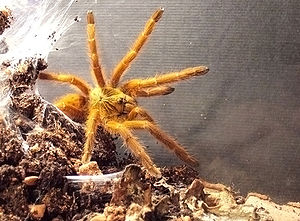Pterinochilus murinus
| Pterinochilus murinus | ||||||||||||
|---|---|---|---|---|---|---|---|---|---|---|---|---|

Pterinochilus murinus , female |
||||||||||||
| Systematics | ||||||||||||
|
||||||||||||
| Scientific name | ||||||||||||
| Pterinochilus murinus | ||||||||||||
| Pocock , 1897 |
Pterinochilus murinus ( Syn .: Pterinochilus mamillatus ), in German sometimes also called Red Usambara tarantula , Mombasa tarantula or, very rarely, woolly tarantula , is a species of spider from the genus Pterinochilus inthe tarantula family (Theraphosidae). It wasdescribedby Reginald Innes Pocock in 1897. Their distribution area is on the African continent in Angola , Central , East and South Africa .
Appearance
The red usambara tarantula occurs in different color forms in its range. These range from bright red-orange or brick red to yellow, beige and brown to gray.
It grows to about four to six centimeters. Male animals only reach a body length of two to four centimeters. The legs, pro- and opisthosoma have the same basic color. The legs have light-colored leg rings. The carapace has a star-shaped pattern. A herringbone pattern can be seen on the opisthosoma . The spinnerets not stand out in color from the rest of the body from. The eye mound sits on a slightly raised part of the anterior carapace. The body is hairy uniformly short. There is some longer hair on the legs. The males have a tibial apophysis with a distinct terminal spine on the first pair of legs .
behavior
In their natural environment, the animals are clearly ground dwellers who dig deep living tubes. In the natural habitat, the animals show their main activity in the rainy season. This species is rather nocturnal. It only comes out in the evening, at dusk.
Reproduction
Once the male has touched the female's cobwebs, it often begins to drum with its buttons. If the female responds with her own drumming with the first two pairs of legs, the male slowly approaches the female's dwelling. When approaching, the male continues to drum, and a vibration of the male can be clearly seen. The female usually comes to the exit of her dwelling, where mating takes place after further drumming and vibrating. The male uses his shin hooks to lift the female up. While drumming one button against the sternum (underside of the front body) of the female, the male inserts the other button into the sexual opening of the female. The buttons are inserted alternately. After successfully inserting both buttons, the male briefly drums the sternum of the female and then quickly flees from the range of the female. If the female does not come out of her home voluntarily, the male tries to lure it out by drumming and vibrating at the entrance. Sometimes the male also goes into the dwelling of the female.
Taxonomy
In 1897 Reginald Innes Pocock established the genus Pterinochilus , to which he put some tarantulas that previously belonged to the genus Harpactira , including Pterinochilus chordatus . In the same work, he also described Pterinochilus murinus as a new species of this genus after a specimen that was found in Tanganyika . The German name refers to the occurrence in the Usambara Mountains , which are also in today's Tanzania and at the time of the first description belonged to German East Africa .
Until the revision of the genus by Richard C. Gallon in 2002, the red color variant was known as Pterinochilus mamillatus . This color variant was described by Embrik Strand as a separate species in 1906 ; However, it was synonymous with Pterinochilus murinus in 2002 .
gallery
Individual evidence
- ↑ Hans W. Kothe: tarantulas. Kosmos-InfoLine, 2009.
- ↑ Natural History Museum of the Burgergemeinde Bern: World Spider Catalog Version 18.0 - Pterinochilus murinus . Retrieved July 10, 2017.
- ^ A b Richard C. Gallon: Revision of the African genera Pterinochilus and Eucratoscelus (Araneae, Theraphisidae, Harpactirinae) with description of two new genera. In: Bulletin of the British Arachnological Society. 12, 5, pp. 201-231, 2002, p. 201.
Web links
Pterinochilus murinus in the World Spider Catalog
- Pterinochilus murinus gallery on premnet.dyndns.org (authentication required)
- baboonspiders.de



